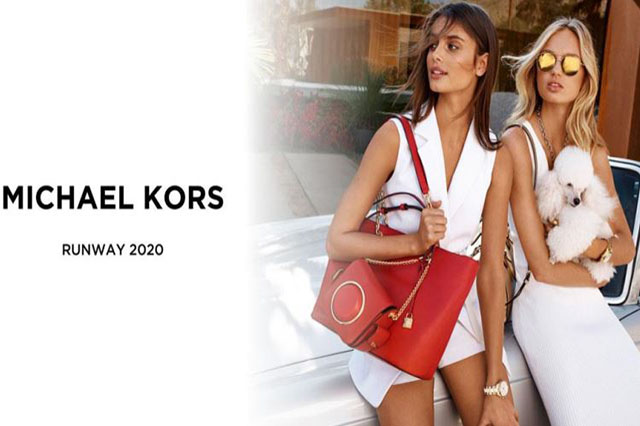Michael Kors Investor Day: Key Points
The Fung Global Retail & Technology team attended the 2017 Michael Kors Investor Day event in New York City. Presenting from the company were:
John Idol, Chairman and CEO
Jaryn Bloom, Group President, Retail
Scott Zalaznik, SVP of Digital and E-Commerce
Cedric Wilmotte, President, EMEA
Patrick Lee, President, Greater China and Southeast Asia
Don Witkowski, President, Men’s
Philippa Newman, President, Collection and MMK Accessories/Footwear
Jill Fishman, SVP, Global Licensing
Dinesh Kandiah, VP, Global Communications
Tom Edwards, CFO and COO
Management kicked off the first annual Michael Kors Investor Day by discussing the company’s history and providing an overview of its Runway 2020 strategic plan.
Michael Kors is a global fashion luxury brand with 10 global flagship stores and a presence in more than 100 countries and has 3,747 shops. Launched more than 35 years ago, it is now a $4.5 billion company. Since 2012, when it went public, the company has grown revenues at a 28% compound annual growth rate (CAGR), from $1,302 million to $4,494 million. Revenues declined from $4,712 million in fiscal 2016 to $4,494 million in fiscal 2017.
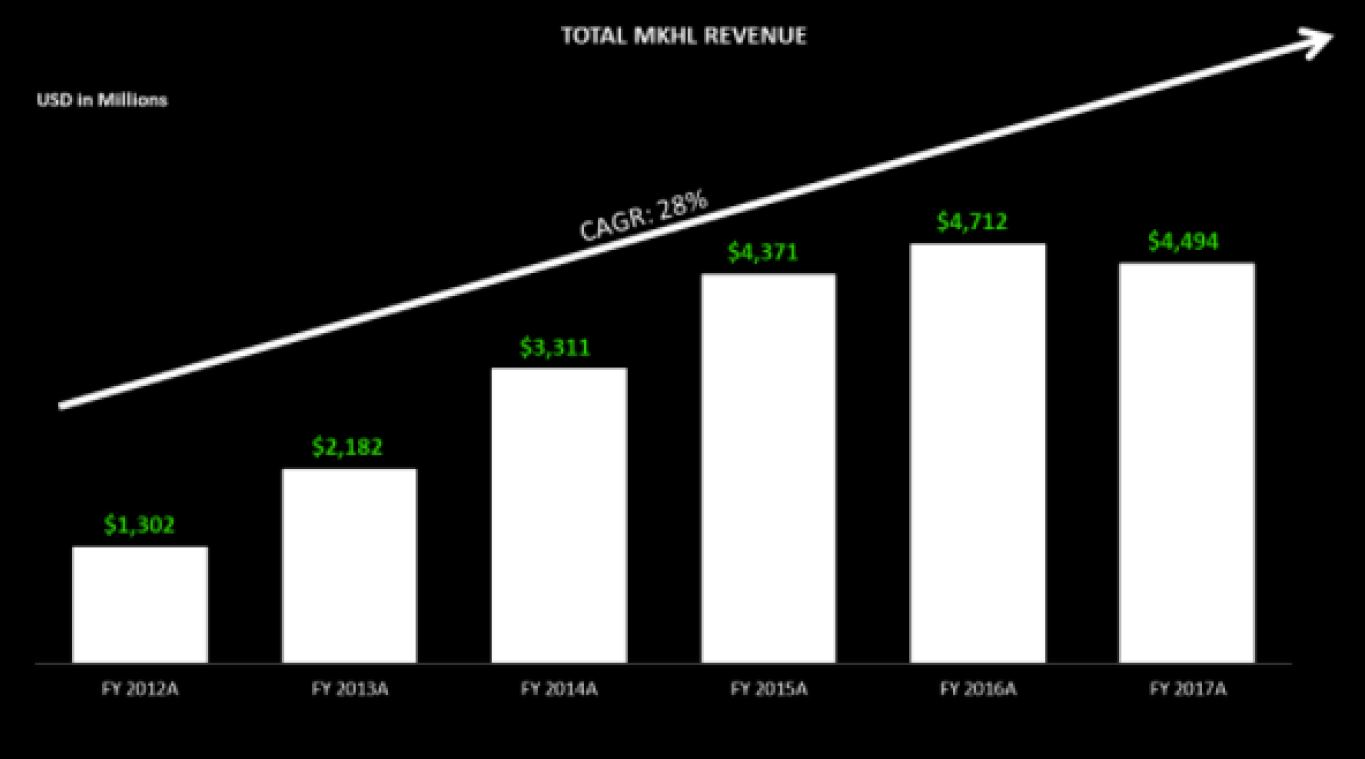
Source: Michael Kors Investor Day presentation
Chairman and CEO John Idol described Runway 2020 as a vision and plan for setting the company up for future growth. Runway 2020 centers on product innovation, novelty and elevating the product image. Management expects fiscal year 2018 to be a transition year and said that it anticipates that product innovation and fleet modernization initiatives will have taken hold by 2020.
The company has three brands: Michael Kors Collection, Michael Michael Kors and Michael Kors Mens.
- Michael Kors Collection is described as a “glamorous sophisticated collection” geared toward a luxury jet-setter customer.
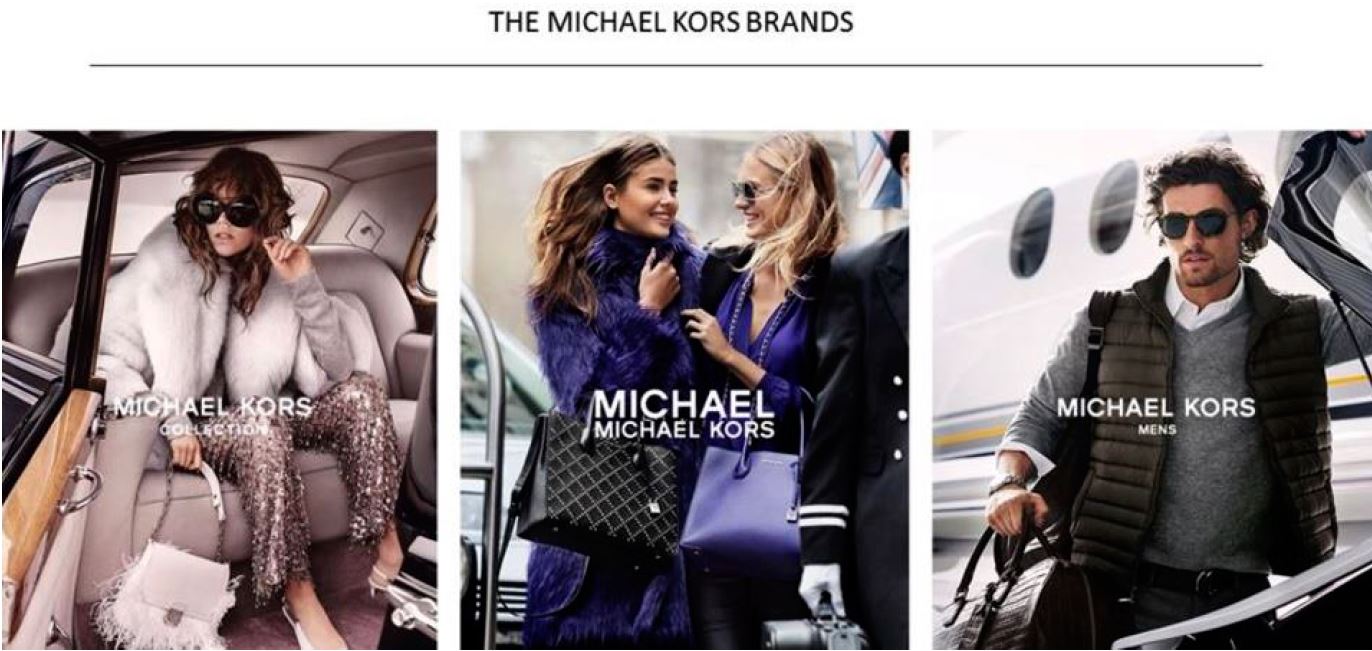
Source: Michael Kors Investor Day presentation
- Michael Michael Kors is positioned to appeal to millennials, a key demographic for the company. Management reported that Michael Kors is a favorite brand among millennials and teens, according to a Goldman Sachs study, and the company sees these younger shoppers as key to its future growth.
- Michael Kors Mens is positioned to appeal to men who are confident, connected and adventurous, with a modern edge. The collection ranges from sportswear to leather goods to accessories for the man on the go.
As the global brand ambassador, Michael Kors himself continues to garner brand attention and social media recognition around the world. For example, he attended three brand events, in London, Seoul and Singapore, in 2015 and 2016, and those events generated 28.2 billion total global press impressions.
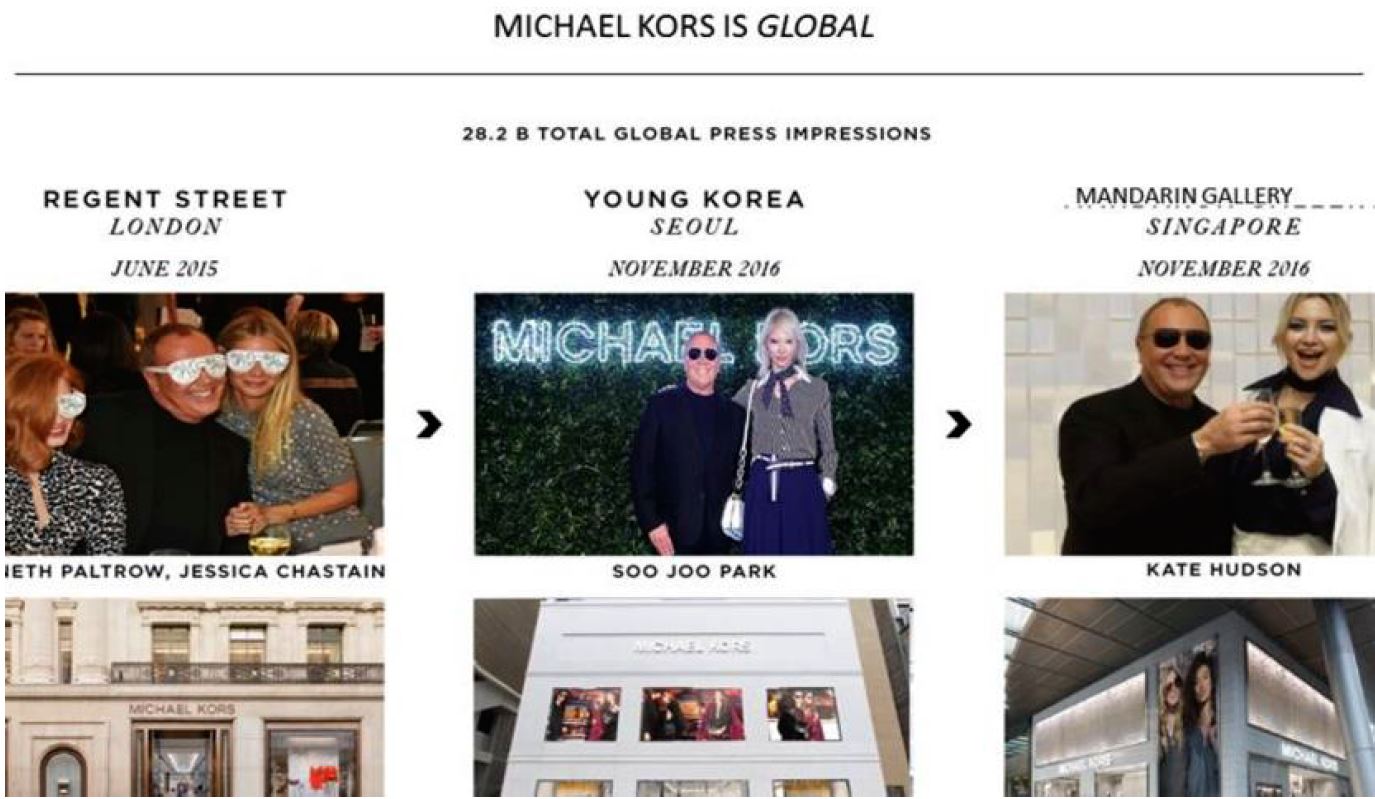
Source: Michael Kors Investor Day presentation
Diversify the Product Mix
Management said that, under the Runway 2020 plan, the company is looking to rebalance its product mix and expand its opportunity beyond accessories. Today, handbags represent 70% of the company’s overall sales, but that share is expected to fall to 62% by 2020. Part of this decrease will result from the company reducing inventory in its wholesale distribution channels. The company projects that the handbag business will see flat to low-single-digit growth through 2020, and that most of the growth in handbags will come from Asia. Additionally, management projects that the North American handbag market will see flat to slightly negative growth over the same period, whereas Europe will see low- to single-digit growth.
Management expects the men’s, footwear and women’s ready-to-wear categories to grow. The biggest increase is expected in men’s: the company expects the category to grow from 3% of sales in fiscal year 2017 to 8% in fiscal year 2020, in both the retail and wholesale channels. Footwear is expected to increase from 11% to 13% of sales over the same period, and women’s ready to wear is expected to increase from 10% to 12% of sales. Each of these categories has a lower margin than the handbag business, but the company reported that its strategy is the right approach, as it provides multiple avenues to reach the customer. The company projects revenue growth in all three categories to be in the low-single digits through fiscal 2020, and said that women’s apparel is the most price-sensitive of the three categories.
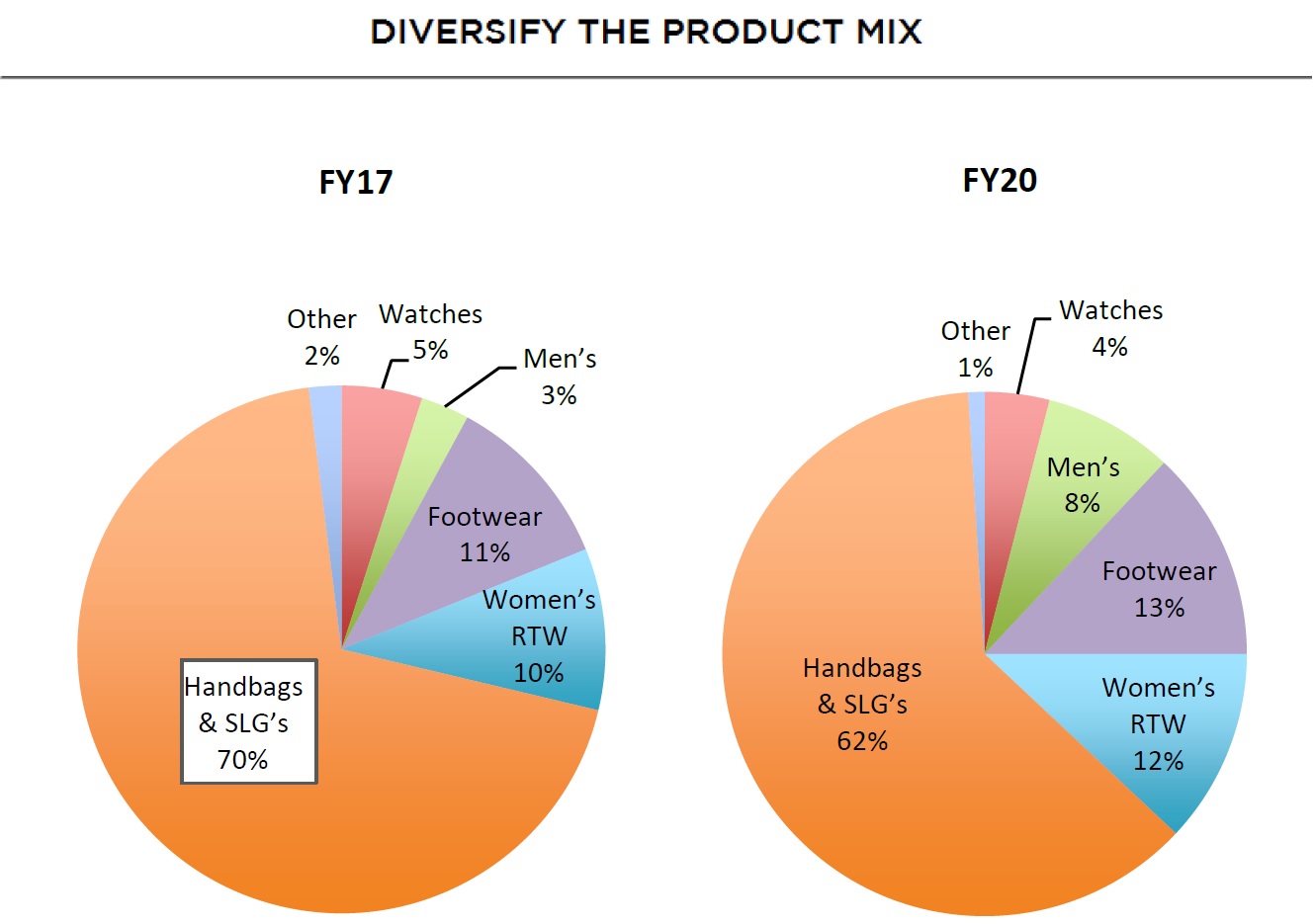
Source: Michael Kors Investor Day presentation
Innovate in Menswear: “Polished Sportswear”
Michael Kors is focused on growing its men’s business, and management described the company’s style offering as “polished sportswear,” which is an update to officewear, where function meets fashion. For example, all men’s pants and woven shirts contain stretchable fabric. Management reported that customer feedback on its men’s line has been very positive. Michael Kors’ biggest competitors in menswear are Hugo Boss and Calvin Klein.
The men’s business is small and new, and management said that it is an area of opportunity. Michael Kors has seen strong growth in sportswear and a better-than-expected response to small leather goods within the men’s category. In the long term, the company believes that it can build its men’s retail business into a $1 billion segment.
Innovate in Smartwatches and Wearable Technology
Management reported that it is focusing on smartwatches and wearable technology,given that the traditional watch category is in decline. The company launched Access, a smartwatch that combines fashion and functionality with customizable faces, interchangeable straps and social connectivity, and the Michael Kors Bradshaw watch was the best-selling Android smartwatch over the 2016 holiday season. The company recently introduced the Grayson men’s smartwatch, which features customization and apps with hundreds of options. Through a strategic partnership with Google, Michael Kors has created an app called MySocial that is available to owners of certain Michael Korssmart watches. The app allows users to upload photos from Instagram to use as their watch faces.
Deliver 40% Less Product
Under the Runway 2020 strategic plan, Michael Kors plans to deliver 40% less product overall with 65%–70% more newness across women’s ready to wear and handbags. By focusing on a narrower range, the company aims to have more focused, elevated product designs.Management noted that a main focus for the team is elevating the iconic Michael Kors handbag components (texture, hardware and logo) to new levels.
The design team is also looking at personalization and customization in order to offer customers handbag options for monograms, reversible colors, straps, key chains, charms and scarves. For example, the company introduced reversible jackets for its signature Selma handbag, shown below.
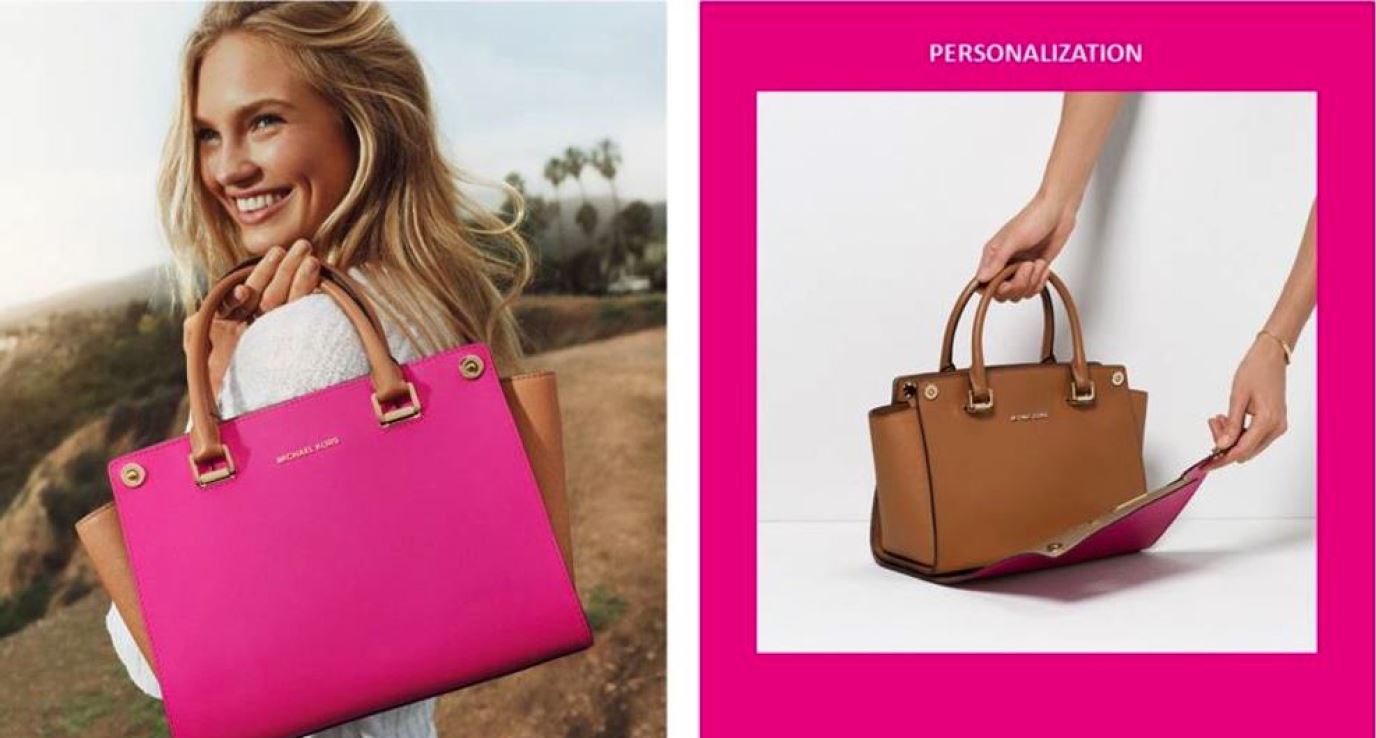
The Selma 3-in-1 handbag
Source: Michael Kors Investor Day presentation;
The penetration rates of new collections increased from 20% for the spring 2017 collection to 37% for the fall 2017 collection. The company estimates that the penetration rate of new collections in accessories will grow to 65%–75% by spring of 2018.
Reduce Promotional Activity, Increase Average Unit Retail (AUR)
The company has committed to having 40% fewer promotional days in its North America Michael Kors lifestyle stores and in its partner/wholesale channels, and management said that it is seeing AUR rising as a result of the change. The company has also identified three items that will never be promotional, its best-selling Mercer bag, its Hamilton bag and the Access watches, which,combined, account for 25% of business. The company has set four windows of time throughout the year for brand wide promotions for itself and its wholesale partners, and management believes that this new strategy will lead to flat to positive comp growth.
Modernize the Fleet
Michael Kors is modernizing its stores and renovating 100 stores globally. The company is using an elevated flagship model as the prototype, highlighting lifestyle curation. Each new store concept emphasizes Michael Kors as a fashion luxury leader. Cedric Wilmotte, President of EMEA, said that the company has selected 20–25 stores in the EMEA region as part of the modernization process, and that it is diversifying the product mix with women’s ready to wear, footwear and menswear, as those are under penetrated categories.
Over the next 24 months, the company plans to close 100–125 stores globally, which will allow it to increase profitability and result in annualized savings of $60 million.
Michael Kors is also modernizing its wholesale fleet. As part of this strategy, the company is looking to enhance the customer experience through a more elevated shop design. The company is renovating its shops with a “Selfridges Regent Street” concept and optimizing its network of shops-in-shops in Europe.
China Represents a $1 Billion Opportunity
Patrick Lee, President of Greater China and Southeast Asia, spoke about Michael Kors’ store footprint in Asia, with a focus on China. The company has 111 stores in 30 cities in the Greater China region. Lee said that China is a great opportunity for growth, with 88 cities with populations of more than 5 million people. In the long run, the company would like to reach 200 stores in China, where the number of middle-class consumers is expected to rise to 40–50 million, and potentially climb to 100 million, giving the country the largest middle-class population in the world.
China is a big strategic market for Michael Kors. Management projects that, within three years, the brand will have a presence in 335 Asian cities, including 180 Chinese cities. The company has strategically been building its brand name in Asia over the past five years, with flagship stores in key cities such as Shanghai, Beijing, Chengdu, Hong Kong, Taipei, Singapore, Tokyo and Kobe.
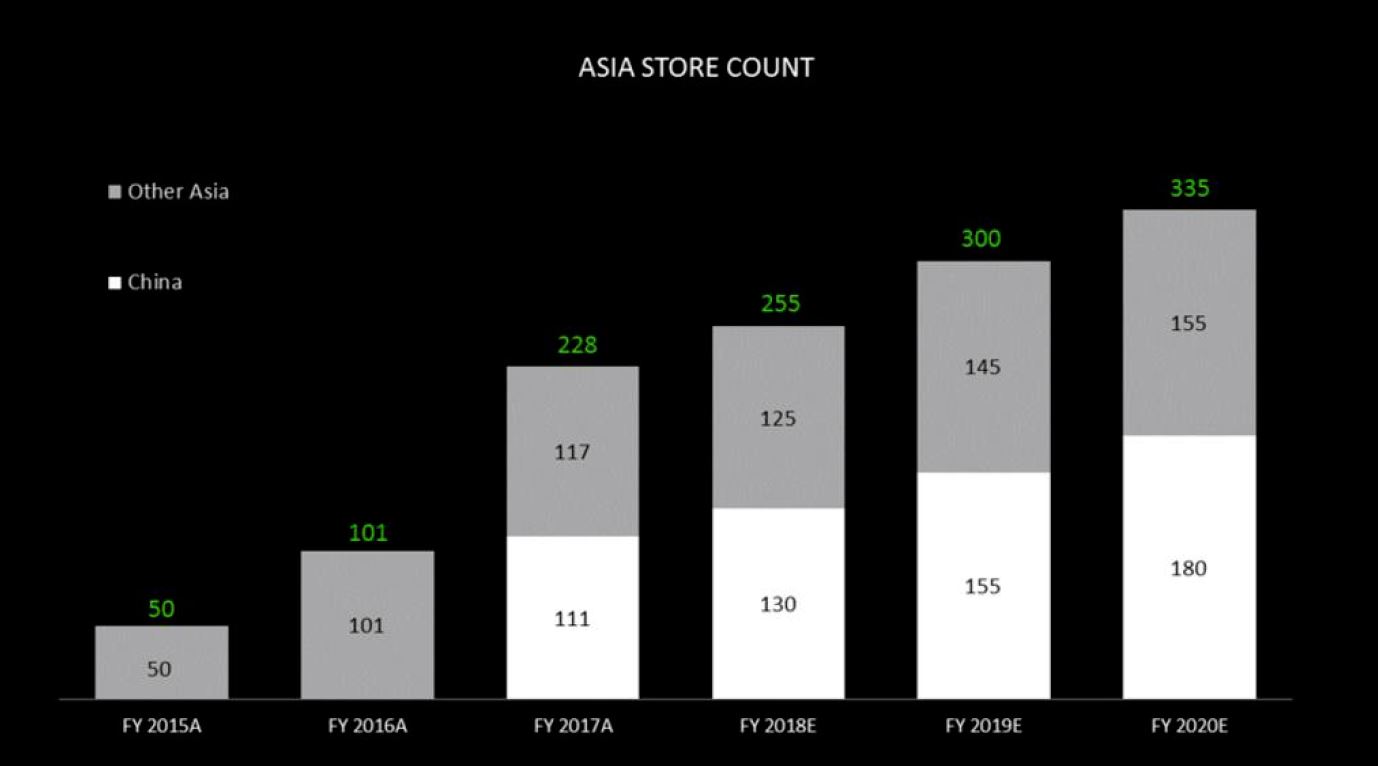
Source: Michael Kors Investor Day presentation
Management said that China represents a $1 billion opportunity for the company. Revenue in the Asia-Pacific region grew at a 110% CAGR from 2012 to 2017, from $10 million to $409 million. The company is trying to build its brand awareness among the growing middle class across Asia and is also working to expand its men’s business into Asia.
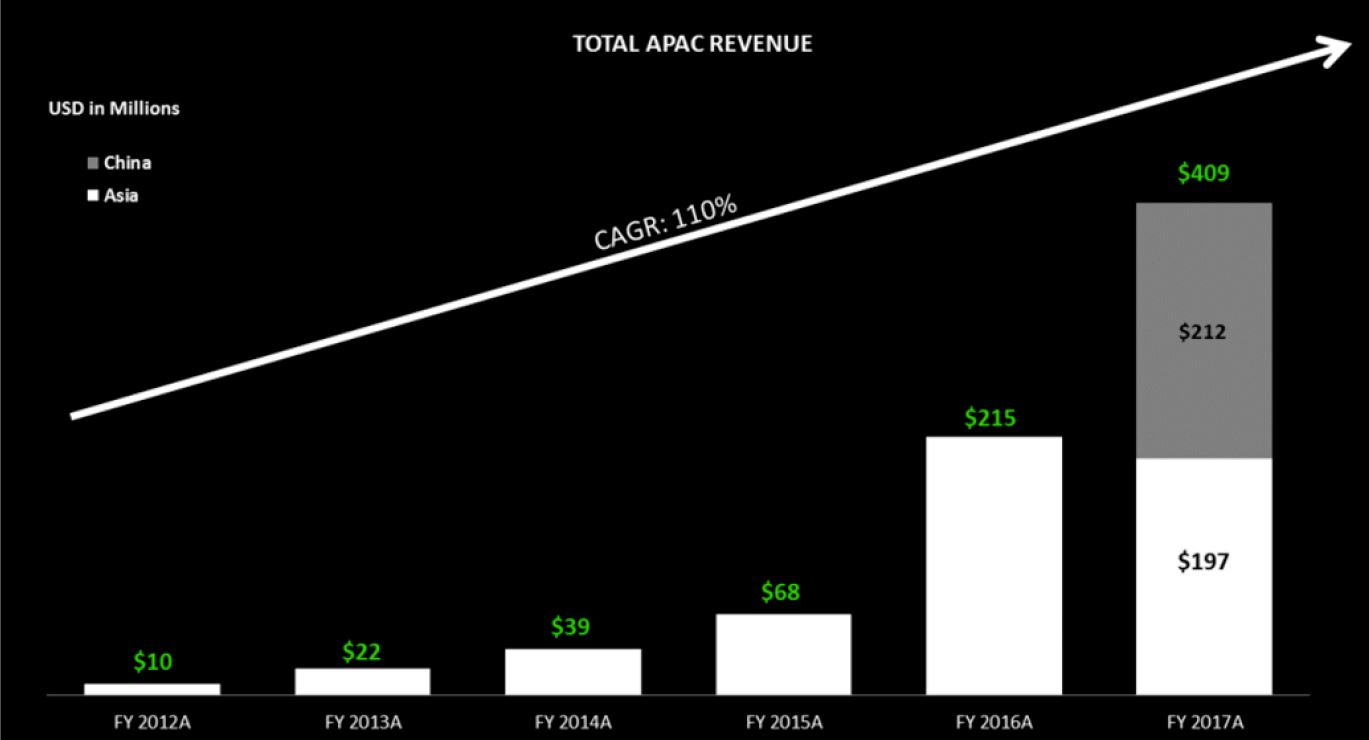
Source: Michael Kors Investor Day presentation
Create Engagement and Loyalty Through Social Media
Michael Kors has almost 36 million engaged social media fans, up 25% from last year. The company is one of the top luxury brands on Instagram, with 10 million followers, and it is continuing to build experiences across all major social media platforms, including WeChat, Weibo, Kakao, Line, Facebook and Twitter.
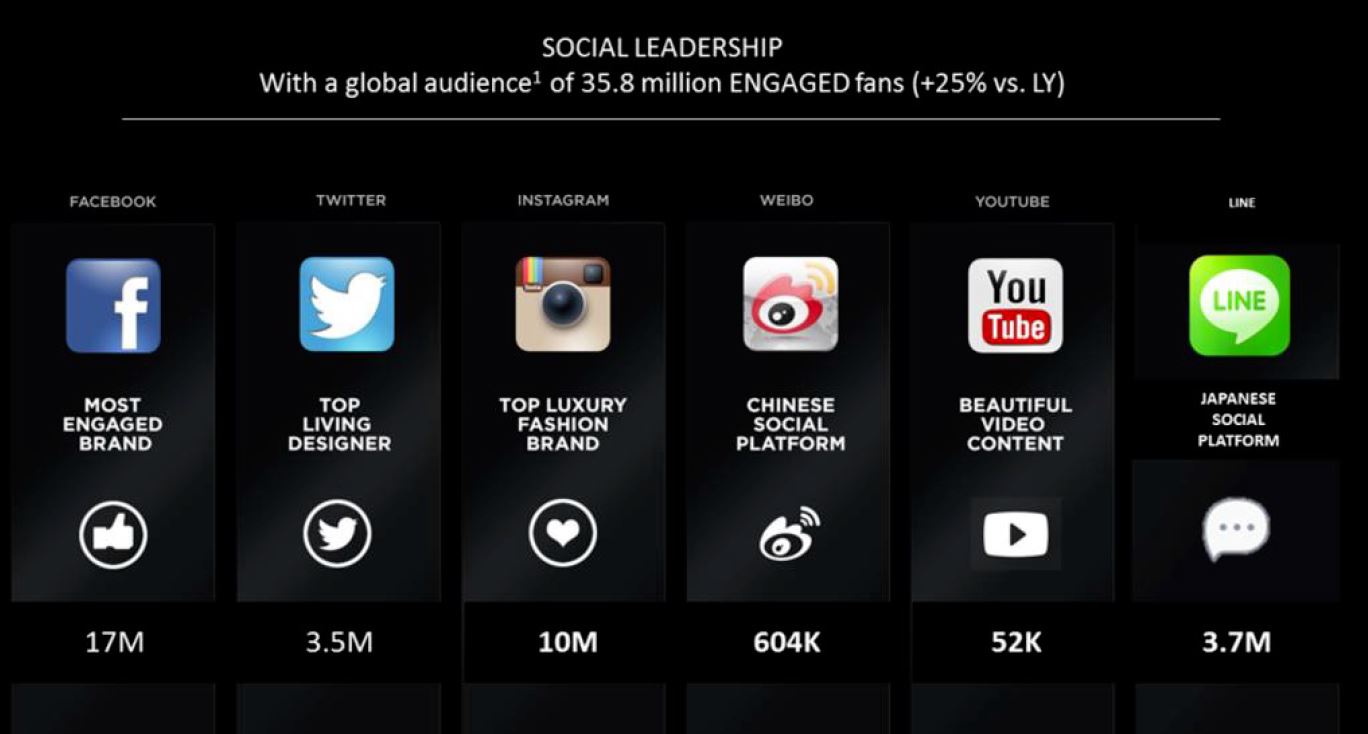
Source: Michael Kors Investor Day presentation
In October 2017, the company will launch KorsVIP, a loyalty styling, fashion and luxury service app. Customers who download the app will be able to chat one on one with a stylist trained by the company. Users can also get “Michael’s” advice and recommendations, and book luxury appointments with a stylist via the app. KorsVIP will also offer special customer loyalty rewards.
Globally, the company has rolled out digital innovations in China, Japan and South Korea. In China, the company is integrating its loyalty program with its international platforms through WeChat and Weibo.

Source: Michael Kors Investor Day presentation
The company says that its Asian customers skew younger (ages 25–35) than in other regions, and that it is working with social influencers in China, Japan and South Korea to engage millennials. In China, YangMi, who has72 million followers on Weibo and WeChat, is Michael Kors’ spokesperson for the Mercer bag.

Source: Michael Kors Investor Day presentation
Challenges and Opportunities
Management discussed the macroeconomic conditions that are impacting the retail environment and the opportunities associated with those conditions:
- Shift in shopping patterns. Mall traffic is declining in North America, as consumers shift more of their shopping to digital channels.Consumers are able to resell products online on sites such as The RealReal, and large marketplaces such as Amazon continue to grow their share of all retail sales. Management said that these channels are taking revenue away from Michael Kors. In response, the company plans to increase its online presence and capabilities, and optimize its store footprint.
- The watch market is in a secular decline. Michael Kors is moving further into the smartwatch category and is partnering with Google and Fossil.
- The global handbag market is maturing. The global handbag market has seen single-digit growth recently. In response, the company plans to rebalance its product mix.
- There is increased competition in luxury handbags. Michael Kors is facing new competition in the luxury handbag space. At least six of its competitors have expanded revenues from $100–$200 million to more than $1 billion. Management said that the opportunity for Michael Kors is to lead in fashion innovation in the category.
- A promotional retail environment has negatively impacted sales. In the past, the company’s retail partners have taken a more promotional stance in order to drive traffic, which has had a negative impact on Michael Kors’ revenue. The company has adopted a new promotional cadence in response.
- The shifting geopolitical landscape has had a negative impact. The US dollar has strengthened considerably, which has cost the company millions due to currency exchange impacts. Government changes and acts of terror have also impacted the company’s sales. In response, the company plans to increase its global presence in both digital and physical channels.
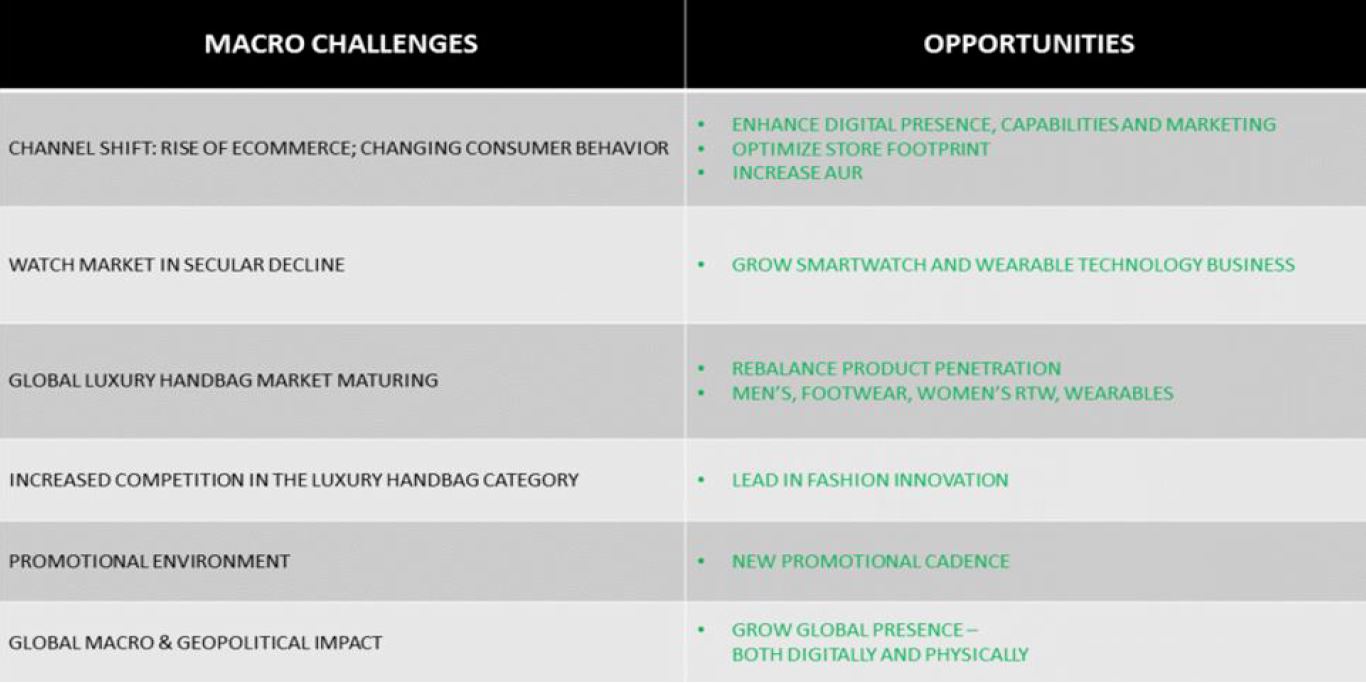
Source: Michael Kors Investor Day presentation
Financial Outlook
Michael Kors projects that it will return to growth by 2020 through its Runway 2020 plan. The company’s plan for improving its operating margin includes improving its segment mix between the wholesale and retail channels and expanding its geographic mix in Asia.
FY 2018: The company has maintained the fiscal year 2018 guidance stated in its fourth-quarter earnings call.Management sees fiscal year 2018 as a reset year to shrink company revenues to a healthy base from which to grow in the future. It also plans to reduce the number of promotional days by 40% across the business.
FY 2019: The company characterizes fiscal year 2019 as a year of stabilizing and building momentum and the top line. The company anticipates that its plan for continued product innovation will help its growth in fiscal year 2019. Management projects that e-commerce will continue to grow across all geographies and segments and that it will experience flat comps in fiscal year 2019 due to the reduction in promotional activities and more consistent promotions. The company expects low-single-digit revenue growth, low- to mid-single-digit EPS growth and a stable gross margin in fiscal year 2019. Capital expenditures are expected to be $200–$250 million in both fiscal year 2019 and 2020, compared with $200 million in fiscal year 2018. The capital expenditures will be used to modernize the fleet, open new stores and invest in IT infrastructure.
FY 2020: For fiscal year 2020, Michael Kors projects that all areas will begin to work together, and that the company will see positive revenue growth, positive comp sales,improving operating and gross margins, and mid- to high-single-digit EPS growth. The table below summarizes the company’s financial outlook for fiscal years 2018 through 2020.
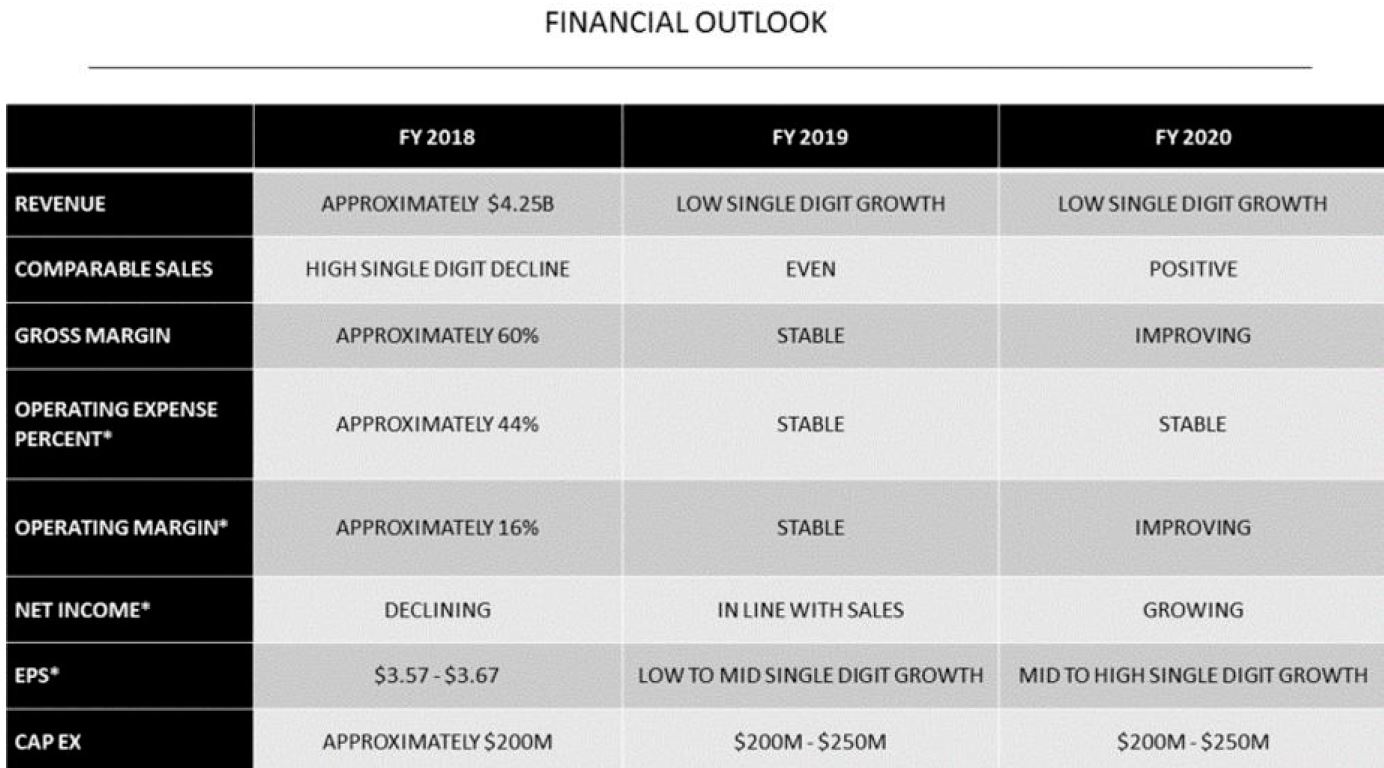
Source: Michael Kors Investor Day presentation
